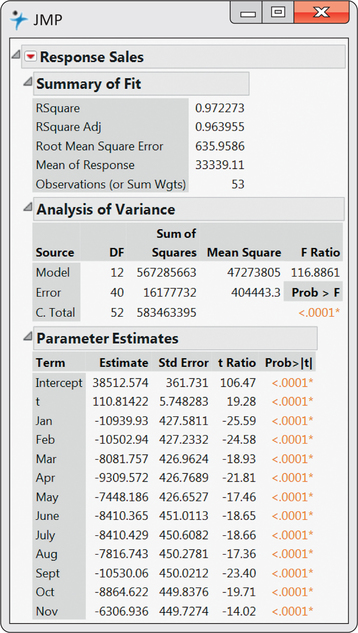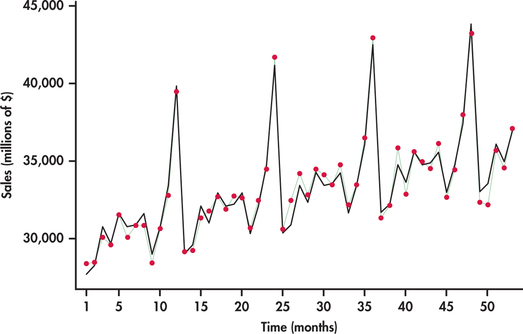EXAMPLE 13.16 Monthly warehouse Club and Superstore Sales
club
The seasonal pattern in the sales data seems to repeat every 12 months, so we begin by creating 12−1=11 indicator variables.
Jan={1if the month is January0otherwiseFeb={1if the month is February0otherwise⋮Nov={1if the month is November0otherwise
December data are indicated when all 11 indicator variables are 0.
We can extend the trend model with these indicator variables. The new model captures the trend along with the seasonal pattern in the time series.
SALESt=β0+β1t+β2Jan+⋯+β12Nov+εt
Fitting this multiple regression model to our data, we get the regression output shown in Figure 13.29. Figure 13.30 displays the time plot of sales observations with the trend-and-season model superimposed. You can see the dramatic improvement over the trend-only model by comparing Figure 13.28 with Figure 13.30. The improved model fit is reflected in the R2-values for the two models: R2=97.2% for the trend-and-season model and R2=32.3% for the trend-only model. The significance of seasonal


variables can be collectively tested with an F-test introduced in Chapter 11. The heart of the test is based on the change in R2. In our case, we find the seasonal variables significantly contribute to the prediction of sales (F=85.15 and P<0.001).
Notice from the regression output that all the monthly coefficients are negative. The reason for this is because of the exclusion of the December indicator variable in the model. December would be associated with all the other indicator variables being 0. When all of these 0’s are substituted into the model, we obtain a baseline trend model fit for the Decembers. Each of the other months have an estimated trend line a certain amount below December depending on the magnitude of the month’s coefficient.
